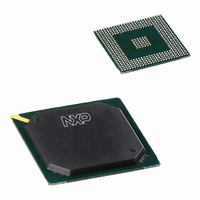PNX1500E/G,557 NXP Semiconductors, PNX1500E/G,557 Datasheet - Page 808

PNX1500E/G,557
Manufacturer Part Number
PNX1500E/G,557
Description
IC MEDIA PROC 240MHZ 456-BGA
Manufacturer
NXP Semiconductors
Specifications of PNX1500E/G,557
Applications
Multimedia
Core Processor
TriMedia
Controller Series
Nexperia
Interface
I²C, 2-Wire Serial
Number Of I /o
61
Voltage - Supply
1.14 V ~ 1.26 V
Operating Temperature
0°C ~ 85°C
Mounting Type
Surface Mount
Package / Case
456-BGA
Lead Free Status / RoHS Status
Lead free / RoHS Compliant
Program Memory Type
-
Ram Size
-
Lead Free Status / Rohs Status
Compliant
Other names
568-1296
935277746557
PNX1500E/G
935277746557
PNX1500E/G
- Current page: 808 of 828
- Download datasheet (4Mb)
NXP Semiconductors
Volume 1 of 1
PNX15XX_PNX952X_SER_N_4
Product data sheet
4.3 Module DMA
4.4 SIMD Programming Issues
4.5 Optional Endian Mode Override
Remark: The packing and ordering of packed bit structure fields in C compilers are
not precisely defined. Typically, big-endian C compilers pack fields from left (msb) to
right (lsb). Little-endian C compilers pack from right to left. Because of this and also
because of inherent inefficient code when accessing structure fields, it is not
recommended to use C structure declarations to access MMIO register fields.
Every DMA capable module in PNX15xx/952x Series observes the system big-
endian signal, and therefore the global SYS_ENDIANMODE.BIG_ENDIAN value, to
determine how to write each data item or unit to memory.
An example of a unit would be:
The module performs byte swapping within units as needed, and packs units as
needed for transmission across on-chip buses. Byte swapping is done in such a
fashion that 8, 16 and 32-bit units always end up in memory bytes in the form
prescribed by the CPU rule. Successive item packing are placed in incrementing
addresses, as designated by the DMA rule.
The module DMA hardware architecture ensures that software dealing with loads and
stores of unit size data can be written in a way that is oblivious to the endian mode.
With the current TM32 CPU core, this is not possible for software that performs Single
Instruction Multiple Data (SIMD) style programming using multimedia operations.
Consider the case of a FIR filter, operating on 16-bit sample units, but using
2-at-a-time load/store/multiply operations. Which of the two 16-bit halfwords is the
earlier sample?
The current TM32 CPU core on PNX15xx/952x Series requires that SIMD software
be written aware of endian mode.
Some PNX15xx/952x Series DMA modules have bits in a control register that allow
override of the global endian mode. Refer to each module for details. This method is
used only in modules that deal with DMA of data of a single, fixed size (in a given
mode). Such modules implement a field that allows selection of the following modes:
•
•
•
•
•
•
•
16-bit audio sample
32-bit audio sample
32-bit unit containing a RGBa 8888 true color pixel with alpha value.
For big-endian mode, the msb halfword contains the earlier sample.
For little-endian mode, the lsb halfword contains the earlier sample.
Normal mode (reset default), obey global PNX15xx/952x Series endian mode
Explicit little-endian, unswapped
Rev. 4.0 — 03 December 2007
PNX15xx/952x Series
Chapter 29: Endian Mode
© NXP B.V. 2007. All rights reserved.
29-808
Related parts for PNX1500E/G,557
Image
Part Number
Description
Manufacturer
Datasheet
Request
R

Part Number:
Description:
Manufacturer:
NXP Semiconductors
Datasheet:
Part Number:
Description:
Digital Signal Processors & Controllers - DSP, DSC NEXPERIA MEDIA PROC 240MHZ
Manufacturer:
NXP Semiconductors
Part Number:
Description:
Digital Signal Processors & Controllers - DSP, DSC PNX1500, 240MHZ
Manufacturer:
NXP Semiconductors
Part Number:
Description:
NXP Semiconductors designed the LPC2420/2460 microcontroller around a 16-bit/32-bitARM7TDMI-S CPU core with real-time debug interfaces that include both JTAG andembedded trace
Manufacturer:
NXP Semiconductors
Datasheet:

Part Number:
Description:
NXP Semiconductors designed the LPC2458 microcontroller around a 16-bit/32-bitARM7TDMI-S CPU core with real-time debug interfaces that include both JTAG andembedded trace
Manufacturer:
NXP Semiconductors
Datasheet:
Part Number:
Description:
NXP Semiconductors designed the LPC2468 microcontroller around a 16-bit/32-bitARM7TDMI-S CPU core with real-time debug interfaces that include both JTAG andembedded trace
Manufacturer:
NXP Semiconductors
Datasheet:
Part Number:
Description:
NXP Semiconductors designed the LPC2470 microcontroller, powered by theARM7TDMI-S core, to be a highly integrated microcontroller for a wide range ofapplications that require advanced communications and high quality graphic displays
Manufacturer:
NXP Semiconductors
Datasheet:
Part Number:
Description:
NXP Semiconductors designed the LPC2478 microcontroller, powered by theARM7TDMI-S core, to be a highly integrated microcontroller for a wide range ofapplications that require advanced communications and high quality graphic displays
Manufacturer:
NXP Semiconductors
Datasheet:
Part Number:
Description:
The Philips Semiconductors XA (eXtended Architecture) family of 16-bit single-chip microcontrollers is powerful enough to easily handle the requirements of high performance embedded applications, yet inexpensive enough to compete in the market for hi
Manufacturer:
NXP Semiconductors
Datasheet:

Part Number:
Description:
The Philips Semiconductors XA (eXtended Architecture) family of 16-bit single-chip microcontrollers is powerful enough to easily handle the requirements of high performance embedded applications, yet inexpensive enough to compete in the market for hi
Manufacturer:
NXP Semiconductors
Datasheet:
Part Number:
Description:
The XA-S3 device is a member of Philips Semiconductors? XA(eXtended Architecture) family of high performance 16-bitsingle-chip microcontrollers
Manufacturer:
NXP Semiconductors
Datasheet:

Part Number:
Description:
The NXP BlueStreak LH75401/LH75411 family consists of two low-cost 16/32-bit System-on-Chip (SoC) devices
Manufacturer:
NXP Semiconductors
Datasheet:

Part Number:
Description:
The NXP LPC3130/3131 combine an 180 MHz ARM926EJ-S CPU core, high-speed USB2
Manufacturer:
NXP Semiconductors
Datasheet:

Part Number:
Description:
The NXP LPC3141 combine a 270 MHz ARM926EJ-S CPU core, High-speed USB 2
Manufacturer:
NXP Semiconductors

Part Number:
Description:
The NXP LPC3143 combine a 270 MHz ARM926EJ-S CPU core, High-speed USB 2
Manufacturer:
NXP Semiconductors










